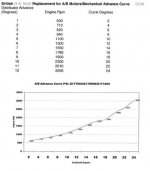Zimmycobra
Senior Member
Offline
Folks - I need your help. I have been reading articles, posts and manuals all day concerning timing my TR4A. I am now totally confused and am looking for your help.
Here is the situation. My 65/66 TR4A has been running fairly well with a poor and uneven idle. I recently had a coil failure. I did a complete evaluation of the ignition system and made a few interesting discoveries.The Lucas 25D distributor is the original one that was cleaned and reinstalled during the restoration a couple of years ago. I replaced the points and coil when I changed the coil recently. What I had not originally checked was the vacuum system. As the distributor had sat for many years in very hot dry environments, i finally realized that the vacuum system was probably bad. When checked the vacuum advance would not hold vacuum. After a bunch of reading and decision making, I replaced the entire system with a new Pertronix III distributor, Flamethrower III coil, and Pertronix spark plug wires. I even replaced the vacuum tube from the front ZS carb to the distributor in case the tube was plugged. The installation went very smoothly, but the car runs the same way. Before I investigate other issues (such as the carbs) I want to be sure that the ignition system is correct. So now to my questions.
Manual says that the static thing should be 4 degrees BTDC. I have read since the restoration that 8 degrees actually runs better. I statically set the timing to be at what I believe is 8 degrees. (Actually, I just installed the Pertronix distributor at the exact same position as the Lucas was when set to 8 degrees.)
How should I set the timing with the new Pertronix system? I have a dial back timing light as well as a standard light. First thing - I will confirm that the TDC mark on my Moss replacement crank pulley (change over kit to smaller belt. No markings.) is correct. Should I then set my timing light to 8 degrees and set the TDC mark on the pointer? If so, do I do it with the vacuum line attached, detached or detached and plugged? Is this the correct timing to start with? How do I check that the vacuum system is indeed working?
Thanks in advance. I am so confused!!!!!

Here is the situation. My 65/66 TR4A has been running fairly well with a poor and uneven idle. I recently had a coil failure. I did a complete evaluation of the ignition system and made a few interesting discoveries.The Lucas 25D distributor is the original one that was cleaned and reinstalled during the restoration a couple of years ago. I replaced the points and coil when I changed the coil recently. What I had not originally checked was the vacuum system. As the distributor had sat for many years in very hot dry environments, i finally realized that the vacuum system was probably bad. When checked the vacuum advance would not hold vacuum. After a bunch of reading and decision making, I replaced the entire system with a new Pertronix III distributor, Flamethrower III coil, and Pertronix spark plug wires. I even replaced the vacuum tube from the front ZS carb to the distributor in case the tube was plugged. The installation went very smoothly, but the car runs the same way. Before I investigate other issues (such as the carbs) I want to be sure that the ignition system is correct. So now to my questions.
Manual says that the static thing should be 4 degrees BTDC. I have read since the restoration that 8 degrees actually runs better. I statically set the timing to be at what I believe is 8 degrees. (Actually, I just installed the Pertronix distributor at the exact same position as the Lucas was when set to 8 degrees.)
How should I set the timing with the new Pertronix system? I have a dial back timing light as well as a standard light. First thing - I will confirm that the TDC mark on my Moss replacement crank pulley (change over kit to smaller belt. No markings.) is correct. Should I then set my timing light to 8 degrees and set the TDC mark on the pointer? If so, do I do it with the vacuum line attached, detached or detached and plugged? Is this the correct timing to start with? How do I check that the vacuum system is indeed working?
Thanks in advance. I am so confused!!!!!

 Hi Guest!
Hi Guest!

 smilie in place of the real @
smilie in place of the real @
 Pretty Please - add it to our Events forum(s) and add to the calendar! >>
Pretty Please - add it to our Events forum(s) and add to the calendar! >> 


